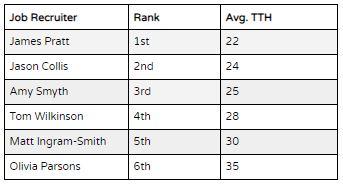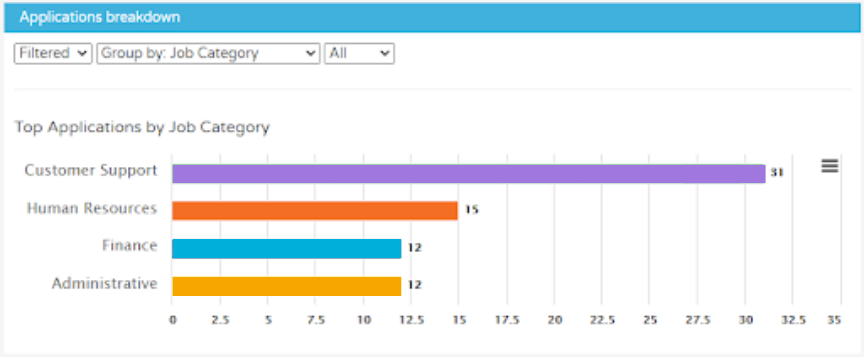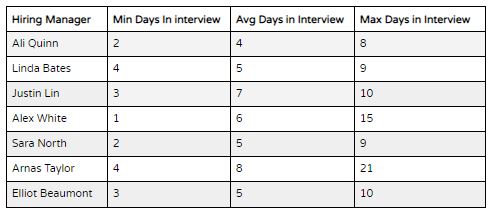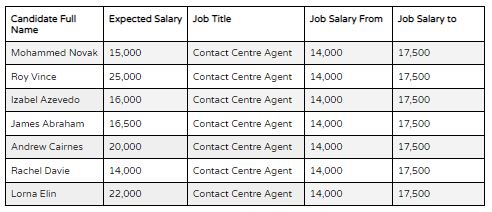Robust reporting functionality is one of the biggest priorities for today’s recruitment software. It’s one of the major drivers away from legacy ATS’s, which are often little more than rewrapped spreadsheets offering limited strategic visibility.
But talking to talent acquisition professionals, we’ve found there’s often less certainty around day-to-day recruitment reporting best practices.
- How can reporting move beyond managing team performance, into driving continuous improvement across the recruitment function?
- What metrics are genuinely valuable to support business decision-making, and which just create paperwork?
- And most critically, how can reporting become a springboard to pinpoint – then solve – your biggest recruitment challenges?
In this article, we’ll answer those questions.
First, we’ll explore the major limitation with legacy reporting and show you a new approach that focuses on outcomes. Then we’ll walk you through a step-by-step blueprint to address one of the most common recruitment challenges: accelerating time-to-hire.
Let’s do it.
How legacy recruitment reporting is letting you down
The last decade’s seen most companies make leaps and bounds in recruitment reporting maturity. But still, most haven’t set-up their reporting in the way that adds most value.
As Kevin Wheeler, Founder and Chairman of the Future of Talent Institute, points out:
“Useful measures should provide the data you need to make meaningful, substantive changes in what you are doing. The most commonly reported recruitment metrics do not meet these requirements.” (Future of Talent)
Kevin’s pointing out that recruitment metrics alone aren’t valuable. Or put another way, it’s not about the data you’ve got but about how you use it.
If you’re using a modern talent acquisition suite you have heaps of data available. Everything you do within your recruitment system is tracked and can form the basis for reports.
But how useful are those reports, really?
If you’re not harnessing your data to solve problems, it’s essentially vanity reporting. A nice pat on the back if you’re hitting KPIs or a warning bell if you’re missing them. But offering little guidance to help you improve.
Harvard Business Review talk about this need for metrics to move the needle on strategic business outcomes:\
“Tying performance metrics to strategy has become an accepted best practice over the past few decades. Strategy is abstract by definition, but metrics give strategy form, allowing our minds to grasp it more readily. […]
If strategy is the blueprint for building an organization, metrics are the concrete, wood, drywall, and bricks” (Harvard Business Review)
For example, say the business’ strategic focus is cross-selling to increase market share across EMEA. To support that, recruitment might need to hire 25% more sales headcount – but simply knowing your fill rate does little to help you achieve that outcome.
It would be much more useful to know your application completion rate is lower for sales roles than elsewhere, for example, and one hiring manager has an 80% lower interview-to-offer rate than average.
The point is, legacy recruitment reporting is discrete and one-dimensional. But best practice reporting is about proactive investigation.
So you can build a comprehensive picture of your complex, multi-faceted recruitment environment – to diagnose your biggest problems and understand where changes need to happen.
Let’s look at a practical example.
An investigative approach to accelerating time-to-hire
We consistently hear from talent acquisition professionals how slow time-to-hire damages the candidate experience and leads to lower application completion, lower offer acceptance rate and empty seats.
So let’s look at how you could use modern recruitment reporting to solve the problem. In four simple steps.
1 – Define time-to-hire
First things first, what do you actually mean by time-to-hire?
Are you measuring time-to-hire from the moment a job is created until a new hire starts? Or from when a job is authorised until an offer’s accepted, maybe? Or when a job’s formally advertised until someone’s hired?
You’ll struggle to diagnose a problem unless you’ve clearly outlined the parameters of that problem. Otherwise, maybe your time-to-hire problem is really an offer process problem. Or a job approval problem.

Above: Setting your metric definitions inside Tribepad Insights
2 – Diagnose the overarching issue
Let’s come back to our example earlier, where you need to hire 25% more sales headcount into EMEA to support the business’ cross-sales strategy.
Slow time-to-hire’s a major spoke in the wheel – so your first step’s likely reviewing time-to-hire across the business.

Above: Reviewing time-to-hire for different job categories in Tribepad Insights
Reports like this are where lots of businesses tend to stop. But they’re the start line, not the finish line.
Knowing your time-to-hire is lower than you’d like is a useful indication you’ll struggle to hit your headcount targets but – like Kevin Wheeler said – it does nothing to guide meaningful, substantive changes.
3 – Drill into possible causes
This is where recruitment reporting starts becoming valuable, moving towards understanding root causes.
So, let’s say your time-to-hire is higher for sales roles than other positions. Now you could dive into time-to-hire by location, to understand whether you’re especially struggling in one region.

Above: Comparing time-to-hire for sales roles by location in Tribepad Insights
Now you know time-to-hire’s higher than average in London, say, you could look at specific recruiters for that region. So now, you don’t just know you’ve got a time-to-hire problem for sales roles. You know whether specific recruiters are causing delays.

Above: Comparing recruiters’ performance for time-to-hire in Tribepad Insights
Or you could look at time-spent in each stage of the recruitment process. Maybe you’re interviewing and making offers fast but slow moving from applications to shortlist, for instance.

Above: Comparing time in-process for each stage in Tribepad Insights
So then you could investigate application volume, to see if you’ve got the right volume of people coming in.

Or perhaps you’re shortlisting and scheduling interviews fast, but there’s a roadblock around interview completion and offers. So then maybe you’d analyse hiring manager activity, to spot which line managers are causing delays, where.

Above: Assessing hiring manager interview activity in Tribepad Insights
Or maybe there’s no clear pattern across your process, recruiters or line managers – so you look into the candidates themselves. Maybe time-to-hire’s being pushed up by high dropouts among candidates with higher salary expectations than the job advertised, for example.

Above: Comparing candidates’ expected salary to job salary range in Tribepad Insights
4 – Take action to solve
Here’s where you solve – where reporting truly empowers change and facilitates positive progress towards strategic goals.
Like…
- Maybe you arrange extra training sessions and manager one-on-ones to support under-performing recruiters.
- Maybe you increase recruitment marketing investment into EMEA, to bolster your employer brand and increase application volume.
- Maybe you arrange unconscious bias training for hiring managers with an unusually high CV rejection rate for diversity candidates. Or anonymise CVs.
(Read more: How recruiters are using Tribepad to deliver on diversity)
- Maybe you introduce a formal briefing process between recruiters and hiring managers, to ensure you’re sending them the right people immediately.
- Maybe you automate the offer and onboarding process, so offers get sent, signed and returned faster.
- Maybe you consider increasing salary and incentives to boost offer acceptance, or re-evaluate the seniority of the candidates you need.
- Maybe you amend job adverts to specify salary range upfront, and make sure recruiters are confirming expectations before interview.
Modern recruitment reporting supports better business outcomes
Legacy reporting – and legacy reporting practices, even if you’re using modern talent acquisition technology – only give you one-dimensional data. And that one-dimension data makes it really difficult to drive value. Even if there’s loads of it.
Taking an investigative approach empowers you to zoom right into your biggest recruitment challenges, to pinpoint likely causes and then take action to remedy them.
That’s when recruitment reporting stops being about measuring performance and starts being about driving change.
And if you’re an existing Tribepad client, remember we offer monthly Insights training to elevate your reporting function – register here. Or we can arrange a comprehensive Insights training day for your whole team (normally on-site but right now virtually.) Talk to your account manager if that’s something you’d be interested in.



